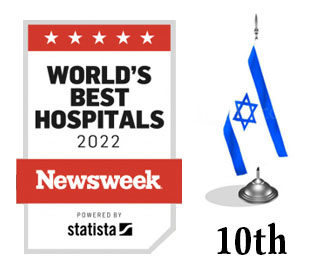A HOSPITAL FOR CHILDREN WITHOUT PAIN — A REAL POSSIBILITY
The philosophy of Safra Children’s Hospital – to cure without pain. High-quality medical services for the treatment for children in Israel
Each of us has the opportunity to accept mercy as a life principle, but it is not a principle that is easy to follow. Only those special people who deeply feel another's pain and are always ready to help the needy can go down this path.
Doctors and nurses, psychologists and social workers, technicians and physiatrists – each of Safra Children’s Hospital’s staff have chosen taking care of children as their profession. This is no coincidence. Due to their input a system for the early detection of pain in children has been developed and instructions and protocols providing for psychological, physical and medication aid to prevent children from experiencing pain have been issued.
Background and Research
40-50 years ago pediatricians knew little on how much children suffer from pain. Previously, it was believed that a newborn does not feel any pain, and a baby feels pain less intensely and forgets the unpleasant feeling faster than an adult.
Babies and toddlers are not able express their pain in words, but studies conducted in recent years have revealed that newborns and prematurely born infants feel the syndrome of pain as intensively as adults do. About two-thirds of children between the ages of 3 to 6 experience severe stress during blood sampling procedures. Such stress can lead to short-term psychological tension and a potential for such of anxiety to develop in similarly stressful situations in future. Approximately 50% of children between the ages of 4 to 10 say that when they think back of the suffering that they endured in relation to their hospitalization, the pain they felt from injections brings makes them feel fearful.
Today we know that any pain-causing procedure must be accompanied with the preventative treatment of the associated pain. The Ministry of Public Health of Israel has issued protocols for minimizing children’s experience of pain based on active distraction techniques and the use various types of anesthesia during painful procedures and checkups.
Trust
At times, a visit to a doctor is not merely an unpleasant experience, but a source of panic and anxiety for a child.
The key to easing anxiety and making contact with medical staff much more comfortable for young patients is the establishment of mutual trust between the patient and the medical professional. A child’s firm belief that no harm will be done to him by the medical professional increases the quality of the cooperation between the child and the physician and increases the potential for a pain and discomfort free treatment; which in the end results in quicker healing. Moreover, this approach helps to calm down the parents whose anxiety only increases child's emotional stress. Thus, a pediatrician needs to work in two directions: to find a suitable treatment option for the child and to find the way to build communication, with the end goal of earning the child’s trust.
Regardless the age of the patient, before each check-up or a procedure a doctor helps him or her to relax and feel involved in the process instead of feeling like an object on which painful manipulations are performed. A conversation, a smile, a game, continuously referring to the child by name, a full explanation of the procedure and answers to any troubling both aid in lowering the child’s stress and make them feel like a partner in the procedure. A close contact between a young patient and medical staff ensures the child's safety and the success of the treatment process. Each member of the medical staff is professionally trained in communicating with patients of all age groups based on understanding the child’s psychology, development, and the stage of his or her disease.
Medical Innovations for Pain Prevention in Children
The hospital utilizes non-invasive diagnostic methods, such as a Bilirubin test. A device called BiliCheck is developed specially for infants and allows for accurate Hepatitis testing simply by gently touching the infant’s skin, therefore avoiding painful skin punctures.
Another new innovative test, which helps avoid pain, changes the way oxygen saturation testing was usually performed. Electrodes connected to the child's finger through a sensor replace invasive blood draws, and the blood saturation data received is complete and accurate.
To ease the child's pain during blood draws, the staff uses complementary methods such as giving a child some sugared water before the test or stimulating the child’s suckling reflex with the dummy. The doctor may also use local anesthesia by applying a numbing cream before the puncture. The effect of local anesthesia may be perceived after 45 minutes, thus the cream should be applied an hour before the blood draw. The wider use of medicines and devices for pain prevention or easement aids in avoiding unnecessary pain and suffering in children.
The Influence of Parents
The fear of pain, experienced during a medical procedure, makes the fear and the pain experienced during the next procedure even worse. As the pain is primary a subjective sensation, it can be significantly intensified by the sensation of anxiety. Often, a child may feel pain at the sight of a doctor, automatically arousing out of the fear of the next visit.
Parents can help their children calm down before and during the procedure by drawing their attention away from the sources of the pain. It is recommended that, before even visiting the hospital, parents explain the medical procedure to the child in detail, answer any questions the child may have, and explain the exact reason for visiting the hospital. Parent should stay together with their child during the entire hospital stay and hospitalization process. Sheba's doctors welcome the opportunity to perform medical procedures on children while they are being help by their parents (if the child’s temperament allows for it.) Such cooperation helps the child feel safe and protected and helps the child overcome the pain and anxiety. Additional techniques used to distract your child's attention include reading fairy-tales, listening to your child’s favorite tunes or playing interesting games. Thus, the child will stay focused on an activity, and not on the pain.
Positive and comforting atmosphere that you find inside the hospital and the friendliness displayed to the patients by each member of the staff also plays an important role. Happy pictures of favorite characters on the walls, bright colors, playrooms and real clowns and generate positive emotions in children, which in return significantly helps them deal with the entire hospital experience.
Welcome to the hospital without pain!




